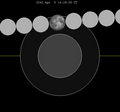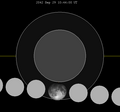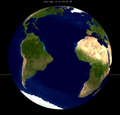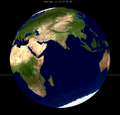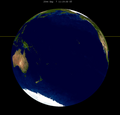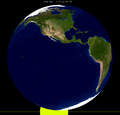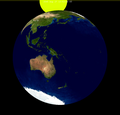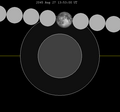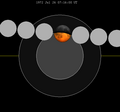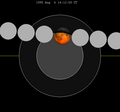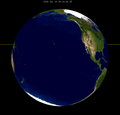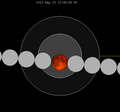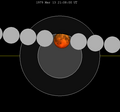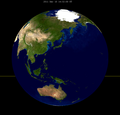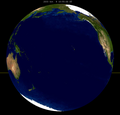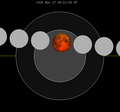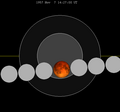Top Qs
Timeline
Chat
Perspective
September 2044 lunar eclipse
Astronomical event From Wikipedia, the free encyclopedia
Remove ads
A total lunar eclipse will occur at the Moon’s ascending node of orbit on Wednesday, September 7, 2044,[1] with an umbral magnitude of 1.0456. A lunar eclipse occurs when the Moon moves into the Earth's shadow, causing the Moon to be darkened. A total lunar eclipse occurs when the Moon's near side entirely passes into the Earth's umbral shadow. Unlike a solar eclipse, which can only be viewed from a relatively small area of the world, a lunar eclipse may be viewed from anywhere on the night side of Earth. A total lunar eclipse can last up to nearly two hours, while a total solar eclipse lasts only a few minutes at any given place, because the Moon's shadow is smaller. Occurring about 5.8 days after apogee (on September 1, 2044, at 16:30 UTC), the Moon's apparent diameter will be smaller.[2]
This lunar eclipse is the last of a tetrad, with four total lunar eclipses in series, the others being on March 25, 2043; September 19, 2043; and March 13, 2044.
This eclipse will also be the first total eclipse of Lunar Saros 138.
Remove ads
Visibility
The eclipse will be completely visible over eastern Australia, northeast Asia, and northwestern North America, seen rising over much of Asia and western Australia and setting over much of North and South America.[3]
  |
Eclipse details
Shown below is a table displaying details about this particular solar eclipse. It describes various parameters pertaining to this eclipse.[4]
Remove ads
Eclipse season
This eclipse is part of an eclipse season, a period, roughly every six months, when eclipses occur. Only two (or occasionally three) eclipse seasons occur each year, and each season lasts about 35 days and repeats just short of six months (173 days) later; thus two full eclipse seasons always occur each year. Either two or three eclipses happen each eclipse season. In the sequence below, each eclipse is separated by a fortnight.
Related eclipses
Summarize
Perspective
Eclipses in 2044
- An annular solar eclipse on February 28.
- A total lunar eclipse on March 13.
- A total solar eclipse on August 23.
- A total lunar eclipse on September 7.
Metonic
- Preceded by: Lunar eclipse of November 18, 2040
- Followed by: Lunar eclipse of June 26, 2048
Tzolkinex
- Preceded by: Lunar eclipse of July 27, 2037
- Followed by: Lunar eclipse of October 19, 2051
Half-Saros
- Preceded by: Solar eclipse of September 2, 2035
- Followed by: Solar eclipse of September 12, 2053
Tritos
- Preceded by: Lunar eclipse of October 8, 2033
- Followed by: Lunar eclipse of August 7, 2055
Lunar Saros 138
- Preceded by: Lunar eclipse of August 28, 2026
- Followed by: Lunar eclipse of September 18, 2062
Inex
- Preceded by: Lunar eclipse of September 28, 2015
- Followed by: Lunar eclipse of August 17, 2073
Triad
- Preceded by: Lunar eclipse of November 7, 1957
- Followed by: Lunar eclipse of July 10, 2131
Lunar eclipses of 2042–2045
This eclipse is a member of a semester series. An eclipse in a semester series of lunar eclipses repeats approximately every 177 days and 4 hours (a semester) at alternating nodes of the Moon's orbit.[5]
The penumbral lunar eclipse on October 28, 2042 occurs in the previous lunar year eclipse set.
Metonic series
The Metonic cycle repeats nearly exactly every 19 years and represents a Saros cycle plus one lunar year. Because it occurs on the same calendar date, the Earth's shadow will in nearly the same location relative to the background stars.
|
|
 |
Saros 138
This eclipse is a part of Saros series 138, repeating every 18 years, 11 days, and containing 82 events. The series started with a penumbral lunar eclipse on October 15, 1521. It contains partial eclipses from June 24, 1918 through August 28, 2026; total eclipses from September 7, 2044 through June 8, 2495; and a second set of partial eclipses from June 19, 2513 through August 13, 2603. The series ends at member 82 as a penumbral eclipse on March 30, 2982.
The longest duration of totality will be produced by member 48 at 105 minutes, 24 seconds on March 24, 2369. All eclipses in this series occur at the Moon’s ascending node of orbit.[6]
Eclipses are tabulated in three columns; every third eclipse in the same column is one exeligmos apart, so they all cast shadows over approximately the same parts of the Earth.
Tritos series
This eclipse is a part of a tritos cycle, repeating at alternating nodes every 135 synodic months (≈ 3986.63 days, or 11 years minus 1 month). Their appearance and longitude are irregular due to a lack of synchronization with the anomalistic month (period of perigee), but groupings of 3 tritos cycles (≈ 33 years minus 3 months) come close (≈ 434.044 anomalistic months), so eclipses are similar in these groupings.
Inex series
This eclipse is a part of the long period inex cycle, repeating at alternating nodes, every 358 synodic months (≈ 10,571.95 days, or 29 years minus 20 days). Their appearance and longitude are irregular due to a lack of synchronization with the anomalistic month (period of perigee). However, groupings of 3 inex cycles (≈ 87 years minus 2 months) comes close (≈ 1,151.02 anomalistic months), so eclipses are similar in these groupings.
Half-Saros cycle
A lunar eclipse will be preceded and followed by solar eclipses by 9 years and 5.5 days (a half saros).[8] This lunar eclipse is related to two total solar eclipses of Solar Saros 145.
| September 2, 2035 | September 12, 2053 |
|---|---|
 |
 |
Remove ads
See also
References
External links
Wikiwand - on
Seamless Wikipedia browsing. On steroids.
Remove ads




